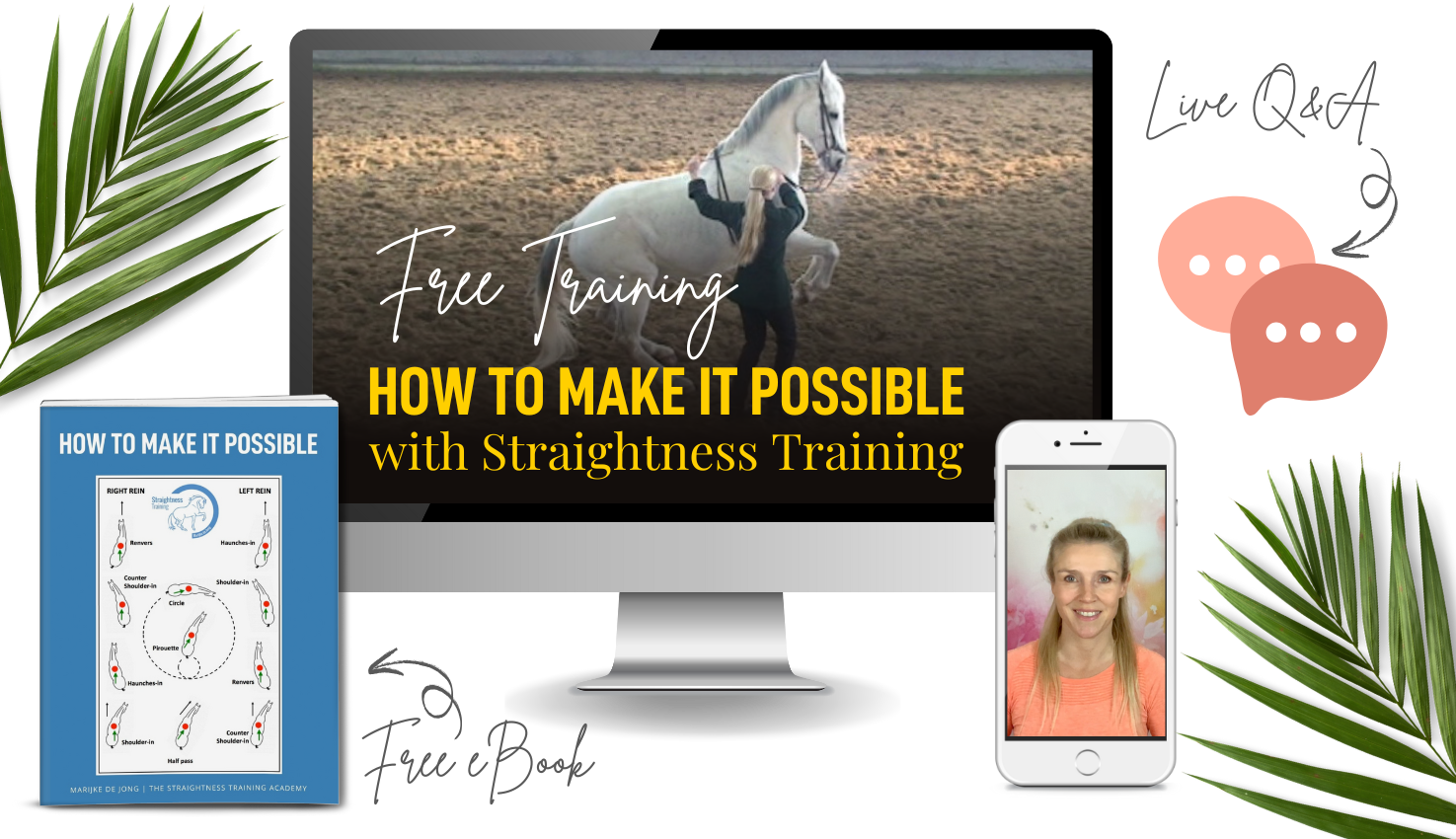
Topline Imbalance
If we don’t correct all the dimensions of natural asymmetry and imbalance, this usually results in a bad posture and an incorrect use of abdominal muscles and back muscles.
In other words, it causes an imbalance in the muscles in the topline and underline of the horse:

Imbalanced topline

Balanced top line
You see, natural asymmetry can create imbalance during riding.
When this is the case, the horse wants to use its head and neck to balance itself.
This makes the horse lift its head up.
But this can only be done when the horse tenses its long back muscle (the ‘longissimus dorsi’).
This muscle is located on both sides of the spine, and when tensed it becomes short, stiff and hard.
Also the underneck muscles start to stiffen.


Symptoms and problems
A hard, stiff back and short topline can cause a whole range of problems:
- Hard mouth
- Underneck
- Head shaking
- Grinding the teeth
- Not wanting to stretch forward-down with the neck
- Not comfortable to sit to in trot
- Lateral gaits
- Prancing
- Slow, not forward
- Short steps
- No tact
- Bridle lame
- Irregular gaits
- Striking, bucking, rearing
- Mental tension and nervousness
- Bad coat; because the blood flow through the tensed back muscles is reduced
- Kissing spines; because of the short topline the spines can start to ‘kiss’ each other.


Now, naturally, we don’t want these problems to arise.
But what to do when our horse already has them?
Let’s investigate this a bit more.
What about your horse?
- Are the muscles in his underneck strongly developed?
- Is it very difficult to ride him ‘on the bit’?
- Is it difficult to ‘sit’ him in trot?
- So you can only do the ‘rising’ trot because he makes you jump up and down in the saddle when you try to keep ‘sitting’?
- Or is it very easy to sit in trot? Almost too easy, that you can’t feel him moving?
In that case, they speak in Germany of a ‘Schenkel Gänger’, which means the horse is only moving the legs, but not using the back muscles. These horses are comfortable to sit in trot, but they don’t use the back properly either…
Now, what to do?
First of all:
Don’t fight the symptoms
Sometimes draw reins are used with horses with a stiff back and stiff mouth, to make the horse lower its head and become soft and round.
Or a sharper bit is chosen.
But here is where things get worse.
You see, all tools that are used to tie the horse in a certain position and force it to hold its head in a certain way are, without exception, more harmful than helpful.
Regrettably enough, it usually creates new problems such as resisting the rider, protest, positioning the head behind the vertical, leaning on the riders’ hand, developing an underneck or lameness.


Also, the saliva glands are squeezed between the lower jaw and the tensed under neck muscles.
This can lead to infections and can inhibit the production of saliva.
Plus, these additional reins ruin the horse’s mouth, because the communication through the bit can only be done with the soft, feeling, living hand of a rider.
So don’t fight the symptoms, rather solve the problem.
The Barometer of the Horse
In most cases, the natural asymmetry in our horse’s body and limbs is the problem.
We could perceive our horse’s body as the ‘weather’.
And we can sense our horse’s natural asymmetry through our reins which have contact with the head of the horse.
We could perceive his head as the ‘barometer’.
Now we all know:
- That the barometer shows you the condition of the weather.
- That you cannot change the barometer to change the weather.
- That the weather needs to change to have another outcome on the barometer.
It’s the same with our horse:
What we’ve not done in behind, we will experience in front.
This means:
If the horse doesn’t have a proper lateral bend in his body, and doesn’t move with supportive hind legs that step under the body, then our horse will not move forward down in front.
He will not yield and search in front.
Instead, he will feel stiff or hard in the mouth.
But it doesn’t help to ‘fix’ the mouth, since it doesn’t help to ‘fix’ the barometer.
We should be able to recognize the symptoms and train the horse in such a way that it can stretch the topline and use its abdominal muscles properly.
Straightness Training will help you to achieve this, and it’s really fun to do!
And if you’d like to learn more on how to refine your horse’s ‘temperature’, then sign up for our free webinar »

